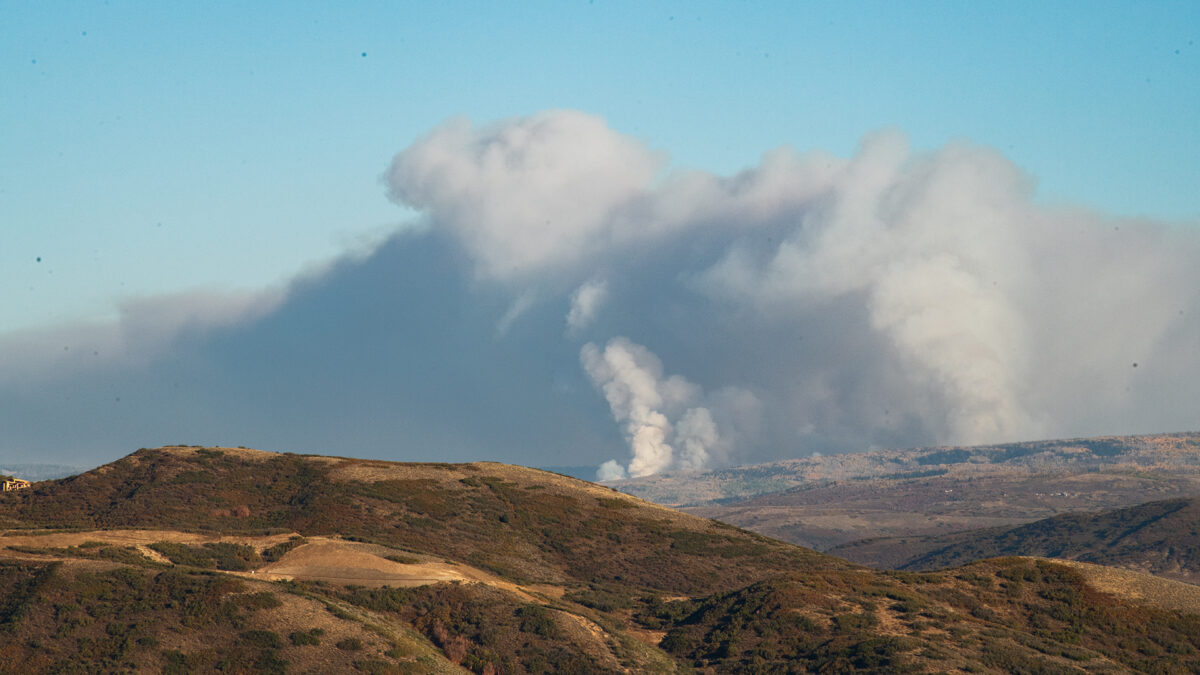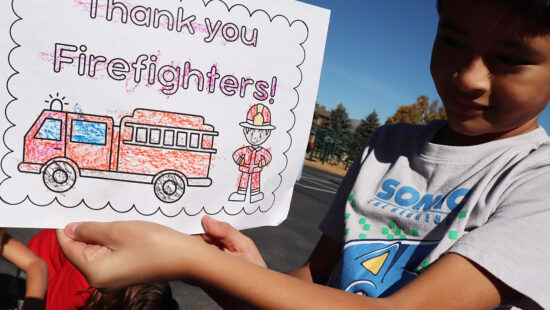Weather
Logging equipment started 33,000-acre Yellow Lake Fire

Yellow Lake Fire as seen from the Jordanelle Reservoir on Thursday evening, Oct. 3, 2024. Photo: Town Lift // Randi Sidman-Moore
KAMAS, Utah – Officials at the U.S. Forest Service have completed the investigation of the Yellow Lake Fire that burned 33,173 acres east of Kamas in the Uinta mountains this fall, determining the cause to be accidental and started by a logging operator’s equipment.
“An investigation conducted by the United States Forest Service Law Enforcement and Investigations concluded the Yellow Lake Fire was accidentally caused by equipment use associated with a timber sale on the Heber-Kamas Ranger District of the Uinta-Wasatch-Cache National Forest,” a U.S. Forest Service statement released this week said.
According to the Bureau of Land Management, timber sales allow for the sustainable harvest of timber for commercial purposes on public land. The commercial harvesting operation was licensed through the U.S. Forest Service.

“What I can tell you as a criminal investigator and having conducted the investigation is, it wasn’t a criminal matter. It wasn’t a civil matter in terms of the U.S. Attorney’s Office, but it’s definitely an administrative matter that’s still underway,” Trey Outlaw, a special agent for the U.S. Forest Service said.
The exact suppression costs for the Yellow Lake Fire have not been publicly disclosed. However, the Silver King Fire, which burned over 18,000 acres in Piute County, incurred estimated suppression costs of around $30 million.
In the beginning, the fire was categorized a type three fire, being managed by a local and state-based team and resources, but as the fire grew, a type one team was called into the suppression effort utilizing airplanes, helicopters and at one point over 700 personnel.
By October 17, the fire had expanded to 33,038 acres and was 30% contained, with 779 personnel engaged in firefighting efforts. The challenging terrain and dry conditions contributed to the fire’s rapid spread, necessitating extensive resources to manage and contain the blaze.
If a logging operator is deemed responsible, they could face significant financial liabilities, past cases suggest. Operators may be required to reimburse government agencies for firefighting efforts, which can run into tens of millions of dollars and they could be responsible for repairing damage to ecosystems, soil, and watersheds.
If found at fault, operator licenses may be suspended or revoked, barring them from future operations.
One example of this is the 2018 Camp Fire in California. Pacific Gas & Electric (PG&E), though not a logging operator, was held liable for sparking the fire due to equipment failures, resulting in billions in liabilities. A logging operator found at fault for a similar disaster would likely face a comparable process, albeit on a smaller scale.
The Yellow Lake Fire consumed vast stretches of wilderness in one of Utah’s most rugged and remote regions. The fire was immediately determined to be human-caused when it was reported on September 28. The fire quickly grew, fueled by dry conditions, dense vegetation, and erratic winds. Over the course of its months-long burn, the fire threatened sensitive habitats and temporarily closed popular recreational areas in the Ashley National Forest.

Firefighters faced significant challenges as they worked to contain the blaze, battling steep terrain and unpredictable weather. A combination of air tankers, ground crews, and strategic firebreaks were deployed to slow the fire’s advance, while resource managers prioritized protecting key watersheds and cultural sites. Despite the intensity of the flames, there were no reported injuries, and firefighters successfully defended nearby campgrounds and trailheads. However, smoke from the fire blanketed the region, impacting air quality in surrounding communities for weeks.
By late October, cooler temperatures and seasonal precipitation finally helped extinguish the flames, leaving behind a stark landscape of charred trees and blackened soil. Ecologists warn that the recovery process will take years, with erosion, invasive species, and water quality among the immediate concerns. However, the fire also opens an opportunity for new growth, with native plants likely to rebound as the ecosystem regenerates.
View this post on Instagram
Yellow Lake Fire burn report shows 86% low soil burn severity
The Yellow Lake Fire Burned Area Response (BAER) report has also been completed. A summary is provided below.
The USDA Forest Service assessed impacts of the Yellow Lake Fire on the soil within the burned area and released an analysis that categorizes the level of soil damage across the affected landscape.
The soil burns severity map, created using remote sensing imagery and field data, identifies four levels of soil burn severity:
- Unburned/Very Low: Minimal soil damage, with intact surface layers.
- Low: Moderate soil damage, with some loss of surface plants but intact topsoil.
- Moderate: Significant soil damage, with substantial loss of plants and potential damage to near-surface roots.
- High: Severe soil damage, with complete loss of plants and deep root damage, making the soil highly susceptible to erosion.
Approximately 86% of the 33,173-acre burned area exhibits low or very low soil burn severity. While 14% of the area experienced moderate damage, less than 1% suffered high severity burns.



















